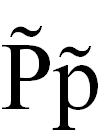This article needs additional citations for verification. (January 2021) |
| P with tilde | |
|---|---|
| P̃ p̃ | |
 | |
| Usage | |
| Writing system | Latin script |
| Type | Alphabet |
| Language of origin | Yanesha |
| Phonetic usage | |
| Unicode codepoint | U+0050, U+0070, U+0303 |
| History | |
| Development |
|
| Other | |
P̃ (majuscule: P̃, minuscule: p̃) is a Latin P with a diacritical tilde. It is or was used as a grapheme in some languages of Vanuatu, such as North Efate, South Efate and Namakura, to represent a sound [k͡p]. It is also used in the Yanesha language.
The letter was introduced by missionaries and has been in use for over a hundred years.
In Bislama, the lingua franca of Vanuatu, p with tilde is called snekpi "snake-P".
In Old English, it was used as a contraction of the penny, as in ⋅cxx⋅ p̃. ("120 pence").
Computer encoding
Unicode encodes p with tilde with a combining diacritical mark (U+0303 ̃ COMBINING TILDE), rather than a precomposed character. As such, the tilde may not align properly with some fonts and systems. In standard HTML code: majuscule P̃, minuscule p̃. The Unicode HTML hex code is: minuscule p̃, majuscule P̃. The Unicode HTML decimal code is: minuscule p̃, majuscule P̃.
References
- ^ Thorpe, Benjamin (1840), "The Laws of King Edgar", Ancient Laws and Institutes of England; Comprising Laws enacted under the Anglo-Saxon Kings from Æthelbirht to Cnut, With an English Translation of the Saxon; The Laws called Edward the Confessor's; The Laws of William the Conqueror, and those ascribed to Henry the First: Also, Monumenta Ecclesiastica Anglicana, From the Seventh to the Tenth Century; And the Ancient Latin Version of the Anglo-Saxon Laws. With a Compendious Glossary, &c., London: Commissioners of the Public Records of the Kingdom, p. 113. (in Old English) & (in Latin) & (in English)